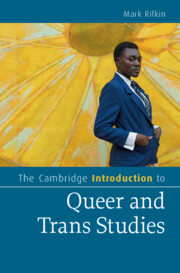Refine listing
Actions for selected content:
1291539 results in Books
16 - Dative and Genitive Variability in the History of English
- from Part II - Tracking Change in the History of English
-
-
- Book:
- The New Cambridge History of the English Language
- Published online:
- 23 October 2025
- Print publication:
- 23 October 2025, pp 449-479
-
- Chapter
- Export citation
Dedication
-
- Book:
- Conversation Memory
- Published online:
- 09 October 2025
- Print publication:
- 23 October 2025, pp v-vi
-
- Chapter
- Export citation
Coda
-
- Book:
- American Modernism and the Cartographic Imagination
- Published online:
- 09 October 2025
- Print publication:
- 23 October 2025, pp 223-229
-
- Chapter
- Export citation
Part III - Contemporary Divisions
-
- Book:
- Civil Religion and the Renewal of American Politics
- Published online:
- 09 October 2025
- Print publication:
- 23 October 2025, pp 155-236
-
- Chapter
- Export citation
Chapter 11 - The Human Sciences and the “Theory of Women”
- from Part III - Interventions
-
-
- Book:
- Science and Humanism
- Published online:
- 09 October 2025
- Print publication:
- 23 October 2025, pp 239-262
-
- Chapter
-
- You have access
- Open access
- HTML
- Export citation
Appendix D: - List of Interviewees
-
- Book:
- Return of Tyranny
- Published online:
- 17 September 2025
- Print publication:
- 23 October 2025, pp 259-266
-
- Chapter
- Export citation

The Cambridge Introduction to Queer and Trans Studies
- Coming soon
-
- Expected online publication date:
- October 2025
- Print publication:
- 30 November 2025
-
- Book
- Export citation
Index
-
- Book:
- Wall Painting, Civic Ceremony, and Sacred Space in Early Renaissance Italy
- Published online:
- 19 September 2025
- Print publication:
- 23 October 2025, pp 459-472
-
- Chapter
- Export citation
Figures
-
- Book:
- Return of Tyranny
- Published online:
- 17 September 2025
- Print publication:
- 23 October 2025, pp xi-xii
-
- Chapter
- Export citation
Figures
-
- Book:
- A History of the Bloomsbury Group
- Published online:
- 09 October 2025
- Print publication:
- 23 October 2025, pp viii-viii
-
- Chapter
- Export citation
9 - Religion’s Role in Social Healing
- from Part III - Contemporary Divisions
-
- Book:
- Civil Religion and the Renewal of American Politics
- Published online:
- 09 October 2025
- Print publication:
- 23 October 2025, pp 181-203
-
- Chapter
- Export citation
Contents
-
- Book:
- The Recognition of Sovereignty
- Published online:
- 09 October 2025
- Print publication:
- 23 October 2025, pp v-v
-
- Chapter
- Export citation
Acknowledgements
-
- Book:
- International Organizations Engaging the World
- Published online:
- 09 October 2025
- Print publication:
- 23 October 2025, pp vii-viii
-
- Chapter
-
- You have access
- Open access
- HTML
- Export citation
2 - How International Organizations Affect the Legal Position of Non-Members
-
-
- Book:
- International Organizations Engaging the World
- Published online:
- 09 October 2025
- Print publication:
- 23 October 2025, pp 20-43
-
- Chapter
-
- You have access
- Open access
- HTML
- Export citation
4 - Big Stimulus Sets
-
- Book:
- Big Data in the Psychological Sciences
- Published online:
- 23 October 2025
- Print publication:
- 23 October 2025, pp 52-69
-
- Chapter
- Export citation
Preface
-
- Book:
- Big Data in the Psychological Sciences
- Published online:
- 23 October 2025
- Print publication:
- 23 October 2025, pp xv-xvi
-
- Chapter
- Export citation
7 - The Empire Central Banks
-
- Book:
- The City's Defense
- Published online:
- 09 October 2025
- Print publication:
- 23 October 2025, pp 255-287
-
- Chapter
- Export citation
Appendix C: - Coding of Revolutions into Ideology-based Categories
-
- Book:
- Return of Tyranny
- Published online:
- 17 September 2025
- Print publication:
- 23 October 2025, pp 257-258
-
- Chapter
- Export citation
Tables
-
- Book:
- The City's Defense
- Published online:
- 09 October 2025
- Print publication:
- 23 October 2025, pp xv-xvi
-
- Chapter
- Export citation
Chapter 8 - Bloomsbury, South Asia, and Empire
- from Part II - Global Bloomsbury
-
-
- Book:
- A History of the Bloomsbury Group
- Published online:
- 09 October 2025
- Print publication:
- 23 October 2025, pp 121-137
-
- Chapter
- Export citation
